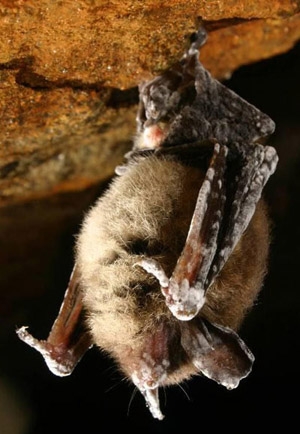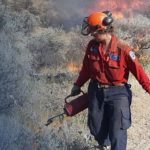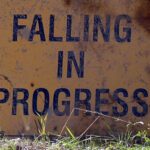Home »

Kimberley wildlife biologist spreading bat awareness
Faces & Places: Leigh Anne Isaac
By Nicole Trigg
Kimberley-based wildlife biologist Leigh Anne Isaac has made a career out of helping conserve a unique group of species that traditionally hasn’t enjoyed mainstream popularity. Snakes, toads and bats have captured her fascination ever since she embarked on a career of wildlife ecology.
“I seem to resonate with these groups of animals that need champions or advocates,” Leigh Anne explained.
Originally from Ontario, Leigh Anne first came to B.C. to receive a national basketball award. Realizing B.C. was where she wanted to spend her future, she moved to Victoria to pursue a Master of Science with a focus on snake thermal ecology (the relationship between temperature and an animal’s ecology), which also fuelled her PhD focus (ecological correlates of crypsis) and led her to Creston for fieldwork.
Impassioned by her time there, Leigh Anne and her husband decided to relocate from Victoria to Kimberley, sight unseen, after she completed her PhD. Keen to connect with other biologists she had met while working in Creston, Leigh Anne reached out and soon became involved in research and conservation work on the endangered northern leopard frog (through Penny Ohanjanian) as well as bats (through Dr. Cori Lausen).
“My background in herpetology (amphibian and reptile studies) was a natural fit for northern leopard frog work, a cold blooded animal with similar types of constraints of their ecology,” said Leigh Anne. “I was very interested in bat research and conservation and wanted to do as much as I could.”
The relationship between bats and temperature was fascinating to her and drew on parallels from her MSc work.
Ten years later, Leigh Anne is a Senior Wildlife Biologist for VAST Resource Solutions, a volunteer member of the Northern Leopard Frog Recovery Team in B.C., a member of the BC Bat Action Team (a non-profit group of bat researchers, educators, conservationists, and government agencies committed to bat conservation), and the coordinator of the Kootenay Community Bat Project focusing on landowner outreach, public education and citizen science initiatives.
“When you live in our region and you’re really interested in something, you can make things happen,” said Leigh Anne. “The key thing for me that I’ve always been so grateful for were the mentors I’ve had at different parts in my career.”
The Kootenay Community Bat Project is currently working on trying to understand as much as they can about Kootenay bats before the White Nose Syndrome, an emerging fungus disease that has killed millions of bats in North America, arrives in B.C.

“White Nose is not in B.C. yet but we are doing everything we can to prepare for this inevitability. The Kootenay region is a challenging place to learn about our bats because it’s big, it’s diverse, and the landscape can be inaccessible or difficult to survey. This is why having our program in place before this threat arrives has been so instrumental.”
This winter, Leigh Anne is asking people to report unusual bat activity, and to report any dead bats they see, up until May 31. Because bats should be hibernating at this time, “unusual activity” is defined as a bat flying or roosting in an area where they are seen by someone during the day.
She reminds everyone to ensure they do not come into direct contact with bats.
The Kootenay Community Bat Project is also looking for Bat Ambassadors, volunteers who are trained by the program to be a local point person for their region. Key areas currently without representation include Invermere, the Elk Valley, and the Slocan Valley.
“We know people want to help and contribute to bat conservation,” said Leigh Anne. “We want to really focus that energy on counting bat roosts. That is key for us because we’re fully expecting White Nose to arrive at some point. If we have an understanding of the number of animals in these sentinel sites, then all of a sudden the population significantly drops, that is definitely going to be a cue for us.”
Leigh Anne characterizes bats’ role in the Kootenay ecosystem as one that provides an incredibly valuable service.
“Bats are foraging on all different sorts of insects and it totals in the hundreds of thousands each night. Nocturnal insect eating is critical to our ecosystems and it’s a role not filled by many animals. It’s hard for us to appreciate what we can’t see or hear.”
Learn more about the Kootenay Community Bat Project. Apply to be a volunteer email Leigh Anne directly at [email protected].
Lead image: Leigh Anne Isaac setting mist nets over water in Lillooet. Photo by Ian Routley
– Nicole Trigg is with the Kootenay Conservation Program, a broad partnership of over 80 organizations from across the Kootenays that works to conserve landscapes in order to sustain naturally functioning ecosystems. Learn more







